We examined the effects of carbohydrate (CHO) delivery format on rates of exogenous CHO oxidation, gastrointestinal discomfort, and exercise capacity. All participants gave written informed consent prior to participation and the study was approved by the Ethics Committee of Liverpool John Moores University. In a randomised repeated measures design (after 24 h of high CHO intake (8 g·kg-1) and pre-exercise meal (2 g·kg-1)), nine trained male cyclists ingested 120 g CHO·h-1from fluid (DRINK), semi-solid gel (GEL), solid jelly chew (CHEW), or a co-ingestion approach (MIX). Participants cycled for 180 min at 95% lactate threshold followed by an exercise capacity test (150% lactate threshold). Peak rates of exogenous CHO oxidation (DRINK, 1.56 ± 0.16; GEL, 1.58 ± 0.13; CHEW, 1.59 ± 0.08; MIX, 1.66 ± 0.02 g·min-1) and oxidation efficiency (DRINK, 72 ± 8; GEL, 72 ± 5; CHEW, 75 ± 5; MIX, 75 ± 6%) were not different between trials (all P > 0.05). Despite ingesting 120 g·h-1, participants reported trivial symptoms of gastrointestinal distress across all individual exercise trials. Exercise capacity was not different (all P < 0.05) between conditions (DRINK, 446 ± 350; GEL, 529 ± 396; CHEW, 596 ± 416; MIX, 469 ± 395 sec), all of which were greater than a water only trial completed during familiarisation (231 ± 244 sec; all P < 0.05). Importantly, these data represent the first time that exogenous rates of CHO oxidation (via stable isotope methodology) have been assessed using feeding strategies (i.e., formats and a co-ingestion approach) commonly adopted by elite endurance athletes. Data demonstrate that consumption of 120 g·h-1 CHO (in a 1:0.8 ratio of maltodextrin (or glucose) to fructose) is a practically tolerable strategy to promote high CHO availability and oxidation during exercise, independent of the delivery format.
Biomedical Basis of Elite Performance 2022 (University of Nottingham, UK) (2022) Proc Physiol Soc 49, PC23
Poster Communications: Comparable rates of exogenous CHO oxidation and trivial gastrointestinal discomfort when ingesting 120 g/h from a drink, gel, jelly chew or co-ingestion approach
Mark Hearris1, James P Morton1, Carl Langan-Evans1, Jamie Pugh1, Louise Burke2, Trent Stellingwerff3, Javier Gonzalez4
1 Liverpool John Moores University 2 Australian Catholic University 3 University of Victoria 4 University of Bath
View other abstracts by:
Where applicable, experiments conform with Society ethical requirements.

